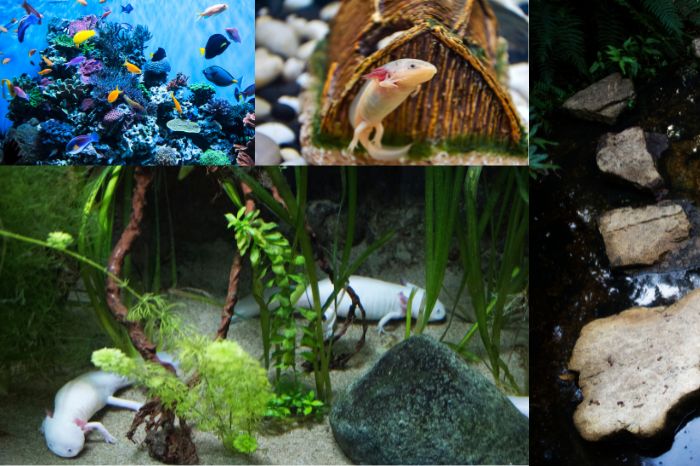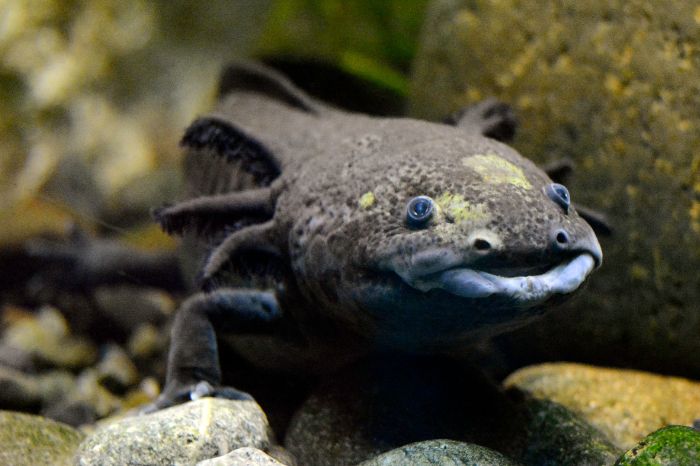Baby Axolotls Complete Care Guide
- Baby Axolotls are staggering pets and proposition a lot to a keeper. Axolotls are extraordinary animals.
If you love to pet fish then petting Axolotls can also be a part of it. They are very affectionate responsive aquatic pets.
Table of Contents
| Read: Why Brown Cats Are Rare?
They can be tracked down in various tones. The Leucistic Axolotl is very beautiful, beside this, Albino and Lucy Axolotl are also very common and attractive.
- Baby Axolotls hatch from delicate eggs following 2-3 weeks of incubation.
- They are sea-going neotenic creatures of land and water and don’t go through complete transformation naturally.
Baby Axolotls require a painstakingly created home to address their issues.
They are particularly delicate to changes, so ecological strength is significant.
Diet, lighting, water temperature, water condition, territory plan, and general well-being are factors in focusing on a youthful Axolotl.
- In general, they are black, gold, and albino. They are the most admired animals and are the family of salamanders.
Wild-type Axolotls are tan and can live for 5-6 years in the wild while captive Axolotls may live for 14-15 years.
- These are highly appreciated amphibians. These are the new creatures that have officially been called extinct.
The most amazing thing about them is that they don’t die after they are matured. Adult Axolotl has amazing regenerative powers.
They also known as Lake Xochimilco Amphibian because it is one of the major lake Xochimilco species. Many called it an Axolotl planet because of its abundance.
- They are also called Mexican Walking Fish as they have short legs.
Care Facts of Axolotl
It makes no sense to start having an Axolotl if you are not willing to give your best.
They need special attention from the beginning. So it is very important to be attentive towards baby Axolotl care.
| What yo know before buying baby Axolotl?
| They are very delicate and should be given the proper amount of food, care, and housing needs.
As mentioned above they are the most fragile of all creatures.
You will find a lot of them in the market but most of them are either dead or ill. The live Axolotl should also be disease free.
They are good swimmer, so this means you will need to provide a swimming space, or it may jump out of the tank.
- They will not have a good time with other Axolotls until they reach sexual maturity.
- Adult Axolotls go through metamorphosis.
- Confine the Axolotl of one sex in a tank with a small territory, the other sex can be kept in the tank, along with the opposite sex.

| Read: Can Rabbits Eat Watermelon
Choosing Your Axolotl Is Important
Impulsivity is not a great trait when it comes to deciding which Axolotl you want to purchase.
Do not just purchase any Axolotl you find. Find an Axolotl that makes you happy.
It is best to purchase an Axolotl from a professional breeder, not a pet store.
It is important to purchase from a professional breeder that is active in the community.
It is likely they will take good care of their animals.
One of my favorite breeders ever is West Florida Axolotls and exotics. They provide healthy baby Axolotls in good condition.
7 Common Health Issues In Axolotl’s
Despite serious areas of strength for being, they are inclined to various illnesses.
The accompanying rundown incorporates a few medical conditions that could hurt youthful Axolotls.
1. Exophthalmia
Exophthalmia, frequently known as projecting eyes, is among the well-being worries that could influence infant Axolotls.
- An Axolotl’s distending eye is normally a sign that it has been managing expanded nitrate focuses for quite a while.
A projecting eye could likewise imply that your creature is developing because of terrible water boundaries.
This condition might be tended to by regularly supplanting the tank water.
You may likewise buy a filtration framework to help with keeping up with ideal water quality.
2. Hyperthermia
Hyperthermia is a clinical issue where your pet overheats because of openness to boiling water.
On the off chance that the water temperature is raised over 73F or 23C, infant Axolotls could foster hyperthermia.
Furthermore, overheating could bring about a drop in the aquarium’s oxygen levels and trigger viral diseases.
- Hyperthermia could be treated by bringing down the tank’s water temperature.
You can rapidly give help to your pet by chilling it off.
Yet, on the off chance that your pet might have bacterial contamination, you might need to begin an anti-microbial drug.
Getting a holder cooling gadget to help keep the aquarium of your Axolotl reliably cold is a great way to deal with keeping away from this.
- The Axolotl will have a blushed, still tongue and excessively red skin. The issues will show up within one to five minutes of being in the water.
3. Overloading
| What do you feed a baby Axolotl?
| Live food until 200 CMS (like worms, daphnia, and small fish larvage).
They have some control over how much food they eat; they can likewise indulge.
Child Axolotls who are overloaded may foster heftiness and other serious medical problems, and in the most horrendously terrible conditions, they might try and kick the bucket.
It is conceivable because of the way that youthful could encounter assimilation issues because of their powerlessness to deal with their food appropriately.
One successful cure is to give your pet a little amount of food that they would gobble up within 1-3 minutes. By doing this, you can ensure that you’re giving them the appropriate nourishment.
- It is advisable to give only a restricted quantity of worms i.e. not more than one worm a day.
- Excess food will make their feces excessively thick, and their rectums will be too loaded, prompting anoxic stasis.
Eating too much and too often can also cause the them skin and gills to rot for the reasons for this please see the dermal and gill rot segment.
- Excess food can be dealt with using low-calorie, low-fat, and high-fiber foods, which can be discovered at pet stores or at a veterinarian’s facility.

| Read: Best Food For Russian Tortoise
4. Starving
Among Axolotls, starving is by and large less destructive than overloading.
Be that as it may, starving might cause deformed advancement and slow development in infant Axolotls.
| How do you train your Axolotl to eat pellets?
| Give them pellets only when they are hungry and make sure to give small pellets for ease.
They would gulp their sustenance and neglect to chew. For this situation, it is continuously better to observe Axolotls young, when they are more reasonable.
- It is also proposed that you don’t place two young Axolotls together in one tank, as they might consume each other.
5. Skin Contamination
Problems in Axolotls’ skin range all the way from sores caused by the tank’s temperature to rough patches caused by salt.
Pustules and Abscesses are constant skin diseases that hurt your young Axolotls.
The most widely recognized skin ailment brought about by subjection to high temperatures is “hot spots.” The spot generally looks like a repulsive, golf ball-sized head that is ordinarily red or pink.
Youthful Axolotls’ skin contaminations are regularly set off by unfortunate water conditions in their tanks, even though microbes could likewise be mindful.
- Keeping up with your young Axolotl in an aquarium with clean water could assist you with forestalling skin illnesses.
6. Wounds
New-born child’s could encounter wounds like losing an appendage, wonderful gills, a little segment of their mouth, and so on.
It commonly happens when you have numerous Axolotls in a solitary aquarium.
- They are fit for going after and at times, in any event, eating each other.
Assuming that an they gets injured in its aquarium, you might recuperate it by isolating it from different creatures.
- To limit future mishaps, you ought to likewise remove any presentations or fenced-in areas with sharp corners from the aquarium.
7. Drifting Topsy Turvy
Child Axolotls may likewise encounter dropping topsy-turvy, which is a huge well-being concern.
- It frequently occurs because of methane development in their guts, stress welcomed on by terrible water conditions and warmth, not having the option to handle the food, and gastrointestinal blockage.
You can take your pet back to the surface by terrifying it. On the off chance that they descend, they may be encountering.
Baby Axolotl Care
| How do you take care of a baby Axolotl?
| Proper water temperature, tank cleanliness, and diet is the basic concern.
An infant Axolotl is similarly a basic lizard to deal with.
It requires a filtration framework and clean water, simply equivalent to a fish.
- Axolotl children need explicit consideration since they are exceptionally vulnerable to water conditions, stickiness, and aquarium oxygen supply.
Subsequently, you should satisfy their tank needs appropriately and screen the water quality to keep up with their fit and vigorous.
Tank Prerequisites and Set-Up
A lovable child Axolotl doesn’t need a lot of room. Additionally, developed Axolotls can flourish in jam-packed conditions.
Both their digestion and level of movement are delayed in this multitude of lizards.
- They needs three fundamental elements to survive. It needs food, oxygen, and an appropriate temperature.
- The temperature of the water, food, and oxygen levels all need to be within acceptable ranges, or your Axolotl might get sick.
You might keep your extraordinary creature in a 10-gallon water tank; notwithstanding, a 20-gallon holder would be the most secure and simple to keep up with.
- You can’t keep Axolotl with tropical fish in an aquarium as they require cool water.
Axolotls frequently discharge significant squander, so giving them a greater water body might assist with keeping up with the water conditions in your aquarium consistently.
Ground region (length and width) ought to be focused on the above level. You want subsequently, a 20-gallon compartment.
Sand or void surface are your two substrate prospects. Axolotl tanks with void surfaces are easy to make due, however on the off chance that your buddy can’t clutch something on a superficial level, it could get discouraging for them.
The most appropriate and get substrate for Axolotls is sand. Sand grains are minute and will not make any significant issues, regardless of whether your pet consumes them.
- They appreciate digging and playing with the sand since it works on their well-being and keeps them from becoming discouraged.
Then, you might add a little vegetation to your aquarium, similar to java grass, nubia barteri, and forward, as they are great decisions, as well as fissures and different hideouts (PVC cuttings or mud pots).
- Even though Axolotls needn’t bother with any unique lighting, extraordinary lights could worry them. The ideal choice is to utilize a tank-driven light since you can change the force.

| Read: Can Rabbits Eat Watermelon
Water Prerequisites
- Poor water conditions lead to disease.
Many things can go wrong if the water in your pet tank is not looked after properly.
- The water temperature may be too hot or cold, or the tank might have too much or too little oxygen.
To work on the life expectancy, satisfaction, and soundness of your child’s Axolotls, it is fundamental to give reasonable water conditions.
- They need good water circulation to get oxygen.
They are therefore sensitive to water filtration and flow. Axolotls can be extremely sensitive to water flow.
- They like temperatures between 60-70 degrees Fahrenheit. They need to live in water that is above 50 degrees Fahrenheit to survive.
Aquatic plants and tank decorations can help maintain the proper water temperature.
- Temperature: 60-70°F (15-23°C)
- pH: 6.5-8.0
- Chlorine: 0 ppm
- Alkali: 0 ppm
- Nitrite: 0 ppm
- Nitrate: 0-10 ppm
- Water Hardness: 7-14 GH
- Carbonated Hardness: 3-8 KH
Some Other Health Issues
| Why are your baby Axolotls dying?
| There are many health issues responsible. The main is the stress due to adjusting to a new environment.
1. Ammonia Poisoning In Axolotl’s
- Ammonia poisoning is a disease caused by elevated levels of ammonia in the water.
- Ammonia levels can get high due to inadequate water changing or uneaten food.
- Ammonia is a by-product of metabolism, and if left to develop, it might kill the Axolotl.
- Ammonia is toxic to them and can be lethal, so regular water changes have to be performed.
Ammonia, in an acidic condition, can burn the their skin. If the water is not changed often enough, or the tank is too small, the ammonia level can rise to dangerous levels.
2) Cryptocaryon
- It is a parasite that can infect Axolotls. It is a mite that attaches to the gills and can spread to other Axolotls in the same tank.
- The parasite can affect the Axolotl’s eyes and gills, resulting in blindness, fin rot, and other infections.
- Treatment for cryptocaryon is typically via antibiotics and antifungals.
3) Fin Rot In Axolotl’s
- The sickness is customary in the wild to a few amphibian species, yet in Axolotls, the sickness can be deadly.
- The sickness impacts the Axolotls’ eyes, which develop outside the body.
- Point when Axolotls get sick, they will require a wellspring of help. Don’t delay in seeing a veterinarian.
- It is a smart thought to work with a vet who deals with amphibians.
4) Captive-Bred Axolotls
- They are prone to infection-related deaths.
- The most widely recognized infections are Septicemia, caused by the release of a toxin by a bacterium called Pseudomonas Aeruginosa (or a different type of bacterium), and Aeromonas, which is caused by the bite of an infected fish or other water creature.
5) Wet Tail Syndrome
- Wet tail syndrome is an ailment related to an infection of the digestive system.
- Typically the infection is caused by a bacterium that is related to the salmonella bug.
- Infections set in when an Axolotl has a state of weakness or if the water temperature is too high

| Read: Is Puppuccino Safe for Dogs?
6) Stress-Related Illness
- Young Axolotls are exceptionally sensitive to stress, like the stress of being removed from their mothers and put in a tank by themselves.
- Stress-related ailments can cause sickness, passing, or stunting of the Axolotl’s development.
7) Mouth Rot (Oral Necrosis, Mouth Fungus)
- Mouth rot is a level of fungal contamination that influences the mouth or jaw of an Axolotl.
- The ailment will eat away at the skin and muscles in the mouth.
- Any type of damage to the tongue or mouth can cause the ailment. The ailment is a genuine danger.
8) Respiratory Infections In Axolotl’s
- Respiratory infections are normally brought on by the introduction of new Axolotls. Axolotls can get diseases from the water and the tank mates.
- Many different types of diseases can affect your pet such as Skin Rashes, Mouth Rot, Respiratory Infections, and more.
- Respiratory infections will show up as runny eyes and gills and fin rot.
9) Dropsy
- Dropsy is a disease where the body swells with water from the lymph nodes. The swelling can make breathing difficult.
- This level of sickness is often fatal.
10) Improper Water Condition
- Ammonia build-up, lack of oxygen, and poor water circulation may also cause Axolotls to become ill.
- High or low levels of chlorine can be harmful to your pet, so be sure to do regular water changes and water testing.
- Hot water can kill them. In the wake of getting to be overheated, your Axolotl will pass an excessive amount of water through its gills.
- This simply means that your Axolotl can drown.
- Make sure to test the temperature of the water regularly.
11) Trouble Breeding
| How can you differentiate a male Axolotl from a female?
| The cloaca (look under its tail near hind legs) of a male Axolotl is larger than a female.
They have a few breeding rituals.
In serious conditions, depriving could likewise take a chance with youthful Axolotls to different problems.
Final Thoughts
- Generally, Axolotls are very versatile to contaminations and infection.
- The greater part of the issues referenced in this article can be forestalled just by rehearsing legitimate cultivation (staying aware of customary aquarium support and taking care of an appropriate eating regimen once every 2-3 days)!
- At the earliest hint of any thought well-being-related issues, test your water boundaries and attempt to figure out the thing that may be going on in light of all that you advanced today.
- On the off chance that you can’t pinpoint precisely the exact thing the issue is, connect with Axolotl specialists.


